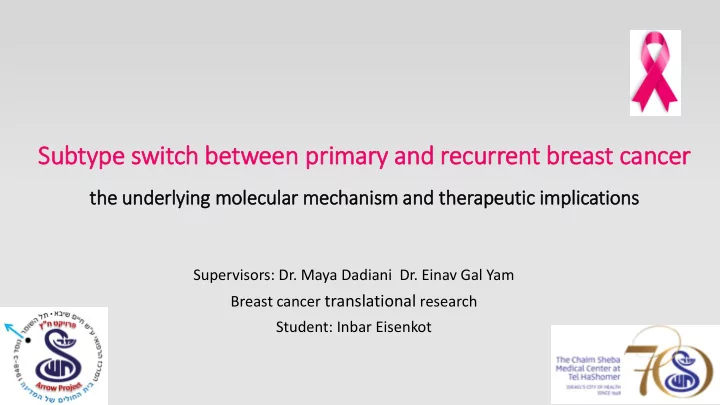

Subtype switch between pri rimary and recurrent breast cancer Su ing molec ism and th the underly th lyin lecula lar r mechanis therapeutic ic im impli licatio ions Supervisors: Dr. Maya Dadiani Dr. Einav Gal Yam Breast cancer translational research Student: Inbar Eisenkot
Breast cancer facts Nature, Outlook Breast Cancer 2012
Breast cancer facts 1.7 million women worldwide are diagnosed with breast cancer each year Nature, Outlook Breast Cancer 2012
Breast cancer subtypes
Genomic and transcriptomic landscape of breast cancer Huge international efforts to profile Breast Cancer TCGA > 2800 tumors METABRIC > 2500 tumors Metastatic BC > 300 tumors TCGA, Nature 490, 61 – 70, 2012
Subtypes Switch • Pathological Subtype: human epidermal Progesterone receptor Estrogen receptor (ER) growth factor type 2 (PR) (HER2) • Molecular Subtype: Subtypes differ dramatically in terms of their gene expression pathways and regulators Sorlie Perou, PNAS, 2001
Clinical Question Does a switch in ER/PR expression Subtype switch usually leads to a change dictate a dramatic reprogramming of the in the subsequent treatment plan molecular signatures? The only remaining option is usually chemotherapy
Study design 2 nd Aim 1 st Aim clinical and pathological characteristics of subtype switch MOLECULAR PROFILING OF MATCHED CASES database and clinical records analysis Primary Recurrence
n=2241 Database screening Patients in DB N=647 Patients with recurrence N=288 Patients with known recurrence subtype ER TN subtype switch rate status in our cohort is 13% which aligns with the literature n=220 Primary: Hormone Positive n=38 n=68 n=182 Stable HR positive HR Positive to HR negative Stable Hormonal Negative patients patients Matched samples
The clinicopathological differences between the cohorts ER TN ER ER TN TN Clinical parameter ER percentage ER intensity PR percentage PR intensity HER2 Age Stage Lymph nodes Grade KI 67 Recurrence location Surgery type Chemotherapy Endocrine treatment RFS OS
ER% in the primary tumor P-value= 1.2x10 −5
Perliminary results Primary Tumor Recurrence ER positive cells Pt #1 Pt #2
ER heterogeneity in the primary tumor: Multiple subtypes in the same tumor? Primary tumor Recurrent metastasis Region 1: ER+++ Region 2: ER-
Molecular Profiling 770 breast cancer related genes
םוכיס • ל םיגווסמ דש ילודיג 3 יפל תוצובק 3 םירוטפצר יגוס : ןגורטסא , ןורטסגורפ ,2 HER הלחמ תרזח תעב םהלש גוויסה תא םינשמ םילודיגהמתיתרורג • 10 - 20% • םירוטפצרה יוטיב ןדבואל תיתועמשמ תינילק תובישח – תוילופיט תויורשפא תוחפ •רקחמה תלאש : גוויסב יוניש רבעש לודיגה םאהירוטפצרה תירלוקלומהו תינילקה ותוגהנתה תא םג הנשמ ? •גוויסה ךופיהב רוזחל הטונש ינושאר לודיג םינייפאמה םיינילקה םירטמרפה םהמ ? תיטסיטטס הזילנא – םינייפאמ תוצובקה ןיב םינוש • ירלוקלומ רקחמ – ירוקמה לודיגהמ הנוש הרזחה תעב לודיגה לש יוטיבה תמיתח םאה ? ינושאר לודיג ותואב םאה לודיגל המוד םהמ הזיאו םינוש םירוזא רפסמ םנשייתרורגה ?
Acknowledgments • Dr. Maya Dadiani • Dr. Einav Gal Yam • Gili Perry • Dr. Nora Balint-Lahat
Recommend
More recommend